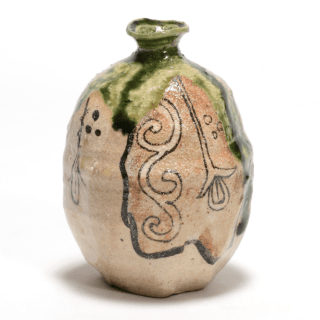
It is with great pleasure that Lucy Lacoste Gallery announces its current exhibition Suzuki Goro: The Story of Oribe, through November 28, 2021, in celebration of the revered Japanese ceramic master’s 80th birthday. In realizing that 2021 was master Suzuki Goro’s 80th birthday year, we knew this milestone was worthy of celebration. Talking to Goro-san, he suggested that all the works be in Oribe, a style known for its eccentricities and free expression.
Oribe originated in the Momoyama period (1573 – 1615) in Japan. While thought of by most as a flowing green glaze, it can be many other colors, including red, black, and brown. Influenced by Japanese fabric design, it often includes drawings in asymmetrical shapes such as squares, rectangles, and circles, on which it is easy to expand, leading to infinite artistic expression. The innovative “Goro” style embodies the spirit of the Momoyama period (spontaneous flowing creativity) combined with his own iconic language drawing on memories of his youth and his life today.
Suzuki Goro is an internationally renowned artist whose life changed from that of an artisan to that of an artist when he discovered pop art in 1969, after a fruitful trip to the USA. Returning to Japan, he was intent on becoming an artist with full expression and individualism.
The work of Suzuki Goro demonstrates a masterful manipulation of the material and an aesthetic of freedom and simplicity. Long admired by Japanese collectors, the work is a favorite of artists and connoisseurs in the United States. Suzuki’s career spans over 60 years, from his early days as a production potter through his tremendous success as an artist of the highest level.
Suzuki Goro’s work has been exhibited extensively in Japan and is included in museum collections in that country such as the Aichi Prefectural Ceramic Museum, the Museum of Fine Arts, Gifu and the Menard Art Museum, Aichi, as well as the United States. His work is represented in the Japanese Pavilion of the Los Angeles County Museum of Art, The Museum of Fine Arts Boston, the Metropolitan Museum of Art, the Peabody Essex Museum, the Worcester Art Museum, the Denver Art Museum and the Marer Collection at Scripps College in Claremont, California. among others.
It is an honor to be showing works of this revered master made especially for this exhibition.
Artist Statement
What's most important when making pottery is the material. What's wanted in the finished product is texture. Ideally, we extract the raw personality of the clay as it was when buried in the ground. Even if buried in the same area, just a small change in location can affect that personality. Appearance is also affected by the glaze, firing method, and conditions we choose. The personality of the fired pot emerges with use.
My theme for this exhibition is Oribe. As you know, Oribe covers several different types of ceramics. Compared to other forms, I feel that Oribe has more breadth for combining images and shapes. More variation makes it more interesting.
About the works:
There are two ways of making Narumi Oribe. Put simply, in one method red clay is painted onto an Oribe clay, and in the other method Oribe clay is joined with the red clay. The works in this show are mainly made by the joining method. This is clear when you look at the Narumi tokkuri with script. The letters "I, ro, ha, ni, ho, he, to" as well as the letters on the Aka Chawan are from the old Japanese alphabet.
The seven chawan on exhibit each represent a different type of Oribe. I hope they show the differences and qualities of each type. I used to make Oribe chawan on the wheel, but lately I have been hand building them as well. (Sou Oribe and Yahichida are wheel thrown; the rest are hand-built).
The wheel gives a feeling of speed, but hand building has warmth and personality, and its different texture is intriguing.
The leaf-shaped pots were shaped by hand-building, then further shaped after throwing on a wheel – both methods have their good points.
The Yahichida water jar has a squishy ["pudding-like"] feeling. I painted a picture on it by running a brush over it with a light touch. This Yahichida illustration was truly lightly and quickly drawn in one stroke. The E-Oribe water jar [mizusashi] was thrown in a way that shows the movement of the wheel – this is a an excellent piece on which I intentionally placed straight lines on that movement-filled shape.
The end-point of these variations are the Oribe Goribe water jars [mizusashi]. As I was making the various types of chawan, I stacked the fired cups up. I became interested in this stack of cups, and decided to make these jars. This could only be made as a Hoso-Mizusashi (tall water jar). I am satisfied with the results.
The picture drawn on the inside of the Tetsu E-Oribe ceramic box is a memento from long ago. In my childhood, I would load grass or vegetables into a pull-cart to carry them. That was my job. As a child, I raised crows from chicks. Crows left a very deep impression on me. I sometimes paint crows as self-portraits. In this show, those pictures appear on my Guinomi [large sake cups]. - Suzuki Goro, 2021
View the digital show catalogue: